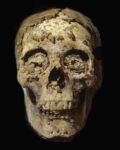 Three mummies with gold tongues have been discovered in a Greco-Roman era tomb at the ancient site of Oxyrhynchus, modern-day Al Bahnasah in Middle Egypt.
Three mummies with gold tongues have been discovered in a Greco-Roman era tomb at the ancient site of Oxyrhynchus, modern-day Al Bahnasah in Middle Egypt.
The Spanish Archaeological Mission, which has been excavating the Bahnasa site for decades, discovered a new necropolis last year. It was a single chamber of polished limestone dating to the 26th Dynasty, the last native dynasty to rule Egypt before it was conquered by Achaemenid Persia in 525 B.C. There were no funerary furnishings remaining in the chamber. In the same dig, they encountered eight later tombs from the Roman era with a domed roof. The tombs contained funerary stele, bronze coins, crosses and clay seals.
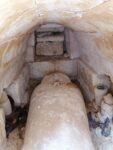 This season’s dig unearthed another two tombs from the 26th Dynasty. One of them had been looted in antiquity, but still contained a female anthropoid stone sarcophagus. Inside were earthenware tiles used to cover the deceased, and a stone amulet of a headrest. The second tomb was still sealed. It contained a male anthropoid sarcophagus containing the mummified remains of man. Niches in the chamber held amulets (scarabs, double feathers, a djed pillar), a ceramic vessel with the remains of bandages, four canopic jars containing the mummified viscera and more than 400 faience ushabti figurines.
This season’s dig unearthed another two tombs from the 26th Dynasty. One of them had been looted in antiquity, but still contained a female anthropoid stone sarcophagus. Inside were earthenware tiles used to cover the deceased, and a stone amulet of a headrest. The second tomb was still sealed. It contained a male anthropoid sarcophagus containing the mummified remains of man. Niches in the chamber held amulets (scarabs, double feathers, a djed pillar), a ceramic vessel with the remains of bandages, four canopic jars containing the mummified viscera and more than 400 faience ushabti figurines.
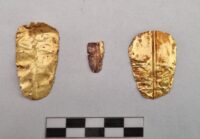 The Roman-era tombs explored this year contained the mummified remains of three individuals, one of them in relatively good condition with surviving hair and soft tissue. Some of the painted cartonnage coffins have also survived. All three of them had an oblong leaf of gold foil in their mouths.
The Roman-era tombs explored this year contained the mummified remains of three individuals, one of them in relatively good condition with surviving hair and soft tissue. Some of the painted cartonnage coffins have also survived. All three of them had an oblong leaf of gold foil in their mouths.
A mummy with a gold tongue was discovered earlier this year at the Taposiris Magna site in Alexandria, 250 miles north of Al Bahnasa. It too 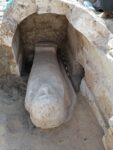 dates to the Roman period when this funerary practice was used as part of a ritual to ensure the dead could speak fluently on their own behalf before the tribunal that would determine whether they were worthy of eternal life. Fourteen golden tongues have been found in the Roman necropolis of Oxyrhynchus.
dates to the Roman period when this funerary practice was used as part of a ritual to ensure the dead could speak fluently on their own behalf before the tribunal that would determine whether they were worthy of eternal life. Fourteen golden tongues have been found in the Roman necropolis of Oxyrhynchus.
Oxyrhynchus is best known for the collection of more than half a million papyrus fragments from an estimated 50,000 papyrus documents first discovered at its ancient garbage dump in the late 19th century. Scholars are still going through this immense treasury of lost ancient literature, private correspondence, shopping lists and even a contract to throw a boys’ wrestling match.
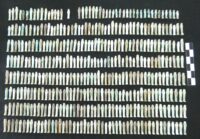
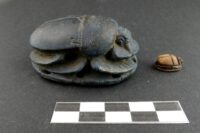
That preciouth shtutter ith thenthational!!! :love:
😮 …”LITHP”!
…tho thorry :confused: